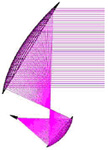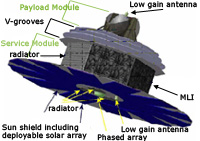Cosmic Microwave Polarisation Mapper
Mission Architecture
A mission concept was identified consisting of a ~1900 kg spacecraft launched by a Soyuz-Fregat into a small-amplitude orbit around the Sun-Earth L2 point. The operational orbit at L2 is selected to maximize the observing efficiency and to provide a stable thermal environment. The nominal mission lifetime is 2 years, plus a possible 2-year extension.
Scientific Objectives
The Cosmic Microwave Background (CMB) is a result of the primordial Big Bang. In the beginning, the Universe consisted of a hot plasma of baryons and electrons. Photons interacted with this plasma through Thomson scattering. As the Universe expanded the plasma started to cool, resulting in the combination of electrons and protons into hydrogen atoms. This happened at a redshift of about 1100 or approximately 370 000 years after the Big Bang. After the formation of hydrogen, Thomson scattering ceased and the photons started to move freely in space. This is why this period is called the time of the last scattering or the recombination period.
The photons have continued to cool since then and today they are at 2.73K - the temperature of the CMB. This temperature was measured with the COBE satellite, which showed that the CMB is strongly isotropic with anisotropies of the order 1 part in 100 000. Later, the WMAP mission measured anisotropies in the intensity of the polarised signal. These anisotropies were formed before and during the last scattering as well as by effects, such as gravitational lensing, occurring after the last scattering. The anisotropies formed before or during the last scattering are of prime interest to CMPM, since these can provide valuable information about inflation theory.
Inflation theory predicts that the early Universe passed through a phase of exponential expansion that was driven by a negative-pressure vacuum energy density. During inflation small quantum fluctuations were created which, after the period of inflation, gave rise to density perturbations. In addition to these scalar perturbations tensor perturbations are also predicted. These perturbations are generated during inflation by gravitational waves. The density perturbations are scalar perturbations causing changes in what is referred to as the E-mode polarisation of the CMB, while the gravitational waves are tensor perturbations causing changes in the B-mode polarisation. The definition of E- and B-mode polarisation comes from the analogy with electric and magnetic field where the electric (E) field has a vanishing curl while the magnetic (B) field has vanishing divergence. The B-mode component of the polarised CMB signal is much weaker than the E-mode component.
The main scientific objective for CMPM is to detect and characterise the B-mode polarisation caused by primordial gravitational waves.
Payload Definition
In order to allow for an adequate definition of the mission requirements and spacecraft resources, preliminary, reference science requirements have been assumed. A selection of 5 science bands was used in the study: 70, 100, 143, 217 and 353 GHz.
Angular resolution
The pattern of CMB anisotropies on the sky can be decomposed using a basis of spherical harmonics where the multipole l corresponds to an angular scale of ~180°/l. At low multipole the B-mode polarisation is mostly assumed to come from primordial gravitational waves. At larger multipoles (above 100) the B-mode is expected to be dominated by gravitational lensing. The resolution should be around 0.5° to allow for measurements down to scales corresponding to a multipole of 360 at the lowest frequency.
Sensitivity
The B-mode polarisation is usually measured by a tensor-to-scalar ratio (r=T/S) where the tensor contribution dictates the amount of B-polarisation in the signal. The goal for CMPM is to be able to measure the B-mode polarisation with r close to 0.001. This goal requires a very sensitive instrument, leading to a sensitivity requirement of around 5 μK arcmin in the prime science band (i.e. 143 GHz). Since there is some uncertainty related to the actual signal intensity, the goal sensitivity in the prime science band is set to 3 μK arcmin. In the case of the frequency bands used for foreground rejection, the required sensitivity level is 5 μK arcmin for the 100 and 217 GHz bands and 10 μK arcmin for the 70 and 353 GHz bands.
Foreground removal
Foreground radiation is expected to dominate the polarised signal received by CMPM. The foreground noise is due to synchrotron emission and spinning dust. In order to fulfil the sensitivity requirements, the foreground needs to be subtracted. The amount of the foreground that needs to be extracted depends on the tensor-to-scalar ratio requirement. Assuming r=0.001, the foreground needs to be reduced to about 10% of its original value. To obtain effective foreground removal, CMPM employs a number of frequency bands. The baseline uses 5 bands in which one is the prime science band (143 GHz) and the other 4 are used for foreground rejection. As mentioned above, the bands used as baseline in CMPM are: 70, 100, 143, 217, 353 GHz.
Observation Requirements and Strategy
The observation strategy is very important in determining the sky coverage and in maximizing the scientific return of the mission. It also impacts on the design of a number of different subsystems. The requirements on the observation strategy are the following:
- To cover the complete sky (or as much of it as possible)
- To make the sky coverage as uniform as possible
- To cover 50% of the sky in 3 days
- To have a minimum number of surveys on the full sky in 6 months.
- To observe at bands of 70, 100, 143, 217, 353 GHz
A dedicated trade-off analysis led to the choice of a baseline scanning strategy that included a precession movement. This strategy envisages a spinning spacecraft with a spin period around the symmetric axis of 0.5 rotations per minute. The precession period was selected to be one hour and the precession angle was selected to be 45 degrees. The telescope bore-sight angle with respect to the spacecraft symmetric axis was selected to be 50 degrees.
Polarisation Method
The approach adopted to detect the polarisation of the incoming CMB is of crucial importance in order to meet the CMPM science requirements. Two options were considered: 1) a rotating half-wave plate; 2) arranging the focal planes with pairs of feed horns that are rotated 45 degrees with respect to each other. In this latter option the polarisation modulation is obtained through alternating the direction of the polarisation sensitivity of feed horns next to each other by 45 degrees. In combination with the satellite spinning/scanning strategy, it is possible to deduct the different Stoke’s parameters needed to obtain the B-mode signal in the CMB.
Due to the technological challenges involved in using half-wave plates (mainly related to the need to rotate the plate in front of the cryogenic detectors with negligible heat loads), option 2 (focal plane elements rotated by 45 degrees) was chosen as the baseline.
Optical System
Optics – Telescope Design
 |
|
The reflective F/1.22 Gregorian optics solution |
| Parameter | Value |
| Primary mirror | |
| Focal length (m) | 0.35 |
| Diameter (m) | 0.65 |
| Secondary mirror | |
| Ellipsoid semi-major axis (m) | 0.28 |
| Interfocal distance (m) | 0.24 |
| Eccentricity | 0.43 |
| Relative orientation of mirrors | |
| Angle between primary mirror axis and secondary mirror |
15 |
Optics – Detector Coupling and Read-out
The choice of coupling between optics and detectors is based on the wavelength range and the specific application needs, and plays a critical role in meeting the science requirements. In the case of the CMPM baseline, the focal planes (~15 cm diameter) consist of 743 feed horns with 1486 Transition Edge Sensors (two per feedhorn) as well as waveguides and SQUID electronics for read-out. The incident radiation arrives via the reflectors, continues through the feedhorns and the waveguides to the TES (Transition Edge Sensor) array. The signals are then read-out by SQUIDs using multiplexing techniques. The feed horns are used to focus the radiation onto the TES-array.
Spacecraft
The CMPM spacecraft consists of a Payload Module (PLM) housing the two telescopes and a Service Module (SVM) that interfaces to the launcher. The PLM and SVM are separated by V-grooves to ensure PLM temperature isolation. Connected to the bottom of the SVM is a deployable sun shield with 24.2 m² solar arrays featuring GaInP2/GaAs/Ge solar cells attached to it. The deployable sunshield is required to ensure that the solar radiation does not interfere with the payload operational temperature.
Service Module
 |
|
Deployed configuration of the CMPM spacecraft |
The CMPM service module consists of an hexagonal structure with a central cone. The SVM houses all avionics units and PLM support systems including:
- the telecommunication subsystem with a phased-array (utilising the X-band);
- the propulsion subsystem using a monopropellant for thrust;
- and the attitude and orbit control subsystem (AOCS) using reaction wheels to control the spinning motion.
The sunshield is based on Gaia heritage.
Payload Module
The payload module consists of a hexagonal structural frame supporting the two reflective telescopes (each with a primary and secondary mirror), two focal plane assemblies and two baffles (one per telescope). A structure cradle, giving support to the optical elements, is attached to the SVM primary structure by means of three bipods.
For the highly sensitive Transition Edge Sensor detectors baselined in CMPM, an operating temperature below 100 mK is needed. This requires a complex cryogenic cooling chain and thermal control system (TCS). To ensure the achieved sensitivity is compliant with the science requirements, the optics also need to be cooled to a temperature of 4K. Based on the mission requirements, the lifetime of the cryogenic system shall be more than 2 years with a goal to extend the mission to 4 years, thus preventing the use of open cycle systems. This leads to a TCS baseline that includes passive cooling down to 50K using V-grooves and active cooling using Stirling coolers, Joule-Thomson coolers and a continuous adiabatic de-magnetisation refrigerator (cADR) to reach the 100 mK operating temperature required by the focal plane detectors.
| Payload Module | |
| Mass | 560 kg dry |
| Telescope | Two F/1.22 Gregorian telescopes |
| Focal Plane | - 1486 TES detectors - 743 feedhorns as radiative elements - Five frequency bands [GHz]: 70, 100, 143, 217, 353 |
| Service Module | |
| Mass | 1330 kg wet |
| Propulsion | monopropellant |
| AOCS | Reaction wheels |
| Power | ~2000 W average (total spacecraft) |
| Communication | 4.3 Mbps (X-band Phased Array) |
Challenges
The main technical challenges of the CMPM mission are listed below.
- Payload:
- Polarisation-modulation schemes capable of providing significant reduction of the effect of systematic errors due to instrumental effects (half-wave plate as opposed to focal plane arrangement).
- The development of ultra sensitive direct detector arrays is critical for the CMPM mission. Areas where substantial improvements are needed include the noise-equivalent power (NEP) performance, manufacturing of large numbers of detector elements, and associated frequency-domain SQUID read-out.
- Cryogenic cooling system for the payload.
- Effects from micro-vibrations (cause by reaction wheels, for example) need further study.
- Spacecraft:
- The data handling system needs to be able to handle a large amount of data and reach a lossless compression factor of 4 in order to fit within the X-band communication limits.
Contact
Ronnie Lindberg
Astrophysics and Fundamental Physics Missions Section (SRE-PAM)
Advanced Studies and Technology Preparation Division
Scientific Project Department
ESA - ESTEC, Keplerlaan 1, 2201 AZ Noordwijk, The Netherlands
Ronnie.Lindberg esa.int
esa.int
Nicola Rando
Head of Astrophysics and Fundamental Physics Missions (SRE-PAM)
Advanced Studies and Technology Preparation Division
Scientific Project Department
ESA - ESTEC, Keplerlaan 1, 2201 AZ Noordwijk, The Netherlands
Nicola.Rando esa.int
esa.int
